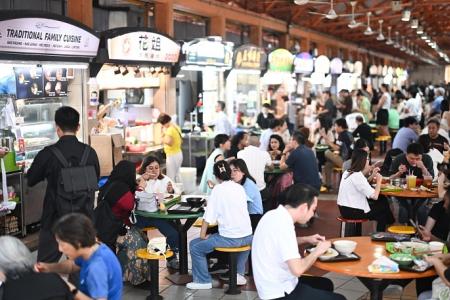Government sets out ways it helps sustain hawker culture
As community dining rooms where Singaporeans from all walks of life gather informally, hawker centres are a central part of the Republic’s identity. The unique touch each hawker puts on their dishes is also what makes hawker culture a beloved institution.
But while hawker culture must be nurtured and supported, doing so requires balancing between inherent tensions that sometimes pull in different directions, Senior Minister of State for Sustainability and the Environment Koh Poh Koon told Parliament on Nov 13.
Speaking during a motion put forth by the Progress Singapore Party (PSP) that called for better support for hawkers, Dr Koh listed the Government’s three objectives in its hawker policy.
These are to ensure that hawker centres continue to provide Singaporeans with affordable food options; help hawkers have a decent livelihood while safeguarding the long-term sustainability of their trade; and to preserve the unique local hawker culture and identity.
While it tries to achieve all three objectives at the same time, it will have to strike a balance between the interests of all parties, said Dr Koh in a five-hour debate that saw about 10 MPs speak.
With global inflation, Singaporeans are understandably concerned about how much they pay for food at hawker centres. At the same time, hawkers also feel these pressures as the rising cost of ingredients form a large part of their operating costs, he noted.
Addressing consumers’ desire for lower food prices can inadvertently run counter to the Government’s aim for hawkers to make a decent living, said Dr Koh. This would also make it more difficult to attract young Singaporeans to the trade, as they have many other career options.
The motion saw PSP Non-Constituency MPs Leong Mun Wai and Hazel Poa put forth a number of suggestions they said would improve the prospects and livelihoods of hawkers here.
One was that each cooked food hawker stall be allowed to employ a work-permit holder as a stall assistant, a suggestion that was seconded by Mr Louis Chua (Sengkang GRC).
This would address the manpower shortage issue and let older hawkers ply their trade for longer, said Mr Leong.
Dr Koh replied that the current policy to allow only Singaporeans and permanent residents to be stallholders at hawker centres safeguards the local identity of the trade. At the same time, the Government ensures low barriers to entry for Singaporeans who wish to enter the food and beverage business by becoming a hawker.
Unlike foodcourts and coffee shops, which are subject to foreign manpower quotas, the aim is to preserve the Unesco heritage of hawker centres where stallholders largely operate their stalls themselves, he added.
He was referring to how Singapore’s hawker heritage was added to the Unesco Representative List of the Intangible Cultural Heritage of Humanity in December 2020.
“That is why we calibrate any relaxation on restrictions on who can work at our hawker centres very carefully... full liberalisation of our hawker centres would significantly alter the make-up and feel of these hawker centres,” he said.
Dr Koh noted that he had in October announced that hawkers will be able to hire from a larger pool of long-term visit pass holders from Jan 1, 2025.
Another suggestion by Mr Leong and Ms Poa is to replace the current tender system with balloting to address the issue of competitive tenders leading to high stall rents.
Dr Koh said that while balloting could provide an equal chance to all to obtain a stall at an upfront fixed rate, it could also encourage frivolous applications and excess demand for stalls at popular locations. Those who genuinely want to set up a stall would see their chances dwindle, and such a situation will not benefit patrons, he added.
Ms Poa also suggested a fixed rent model to keep rental costs under control.
But this would lead to nearly half of all tenderers paying higher rent than they do today, given that based on 2023 data, the tenanted rent for about 44 per cent of stalls is below the assessed market rent, said Dr Koh.
He also pointed to a recent move by the National Environment Agency (NEA) for tendered rents to drop to market rates over six years instead of three years, so as to encourage prospective hawkers to exercise prudence when putting in bids. The change takes effect from NEA’s November tender exercise.
Dr Koh stressed that the Government foots the cost of building hawker centres, and does not use rent for cost recovery. There is no reserve rent or minimum bid price, thus enabling many bidders to obtain stalls at low rental rates.
The current rental process is open, transparent and straightforward for prospective hawkers to understand, and has created a hawker centre landscape that is responsive to consumer demands and changing expectations, and is fair for both hawkers and consumers, he added.
“So we have to be quite careful not to abandon a system that has actually worked quite well and benefited many hawkers just because of a small number of outliers,” he said.
Get The New Paper on your phone with the free TNP app. Download from the Apple App Store or Google Play Store now


